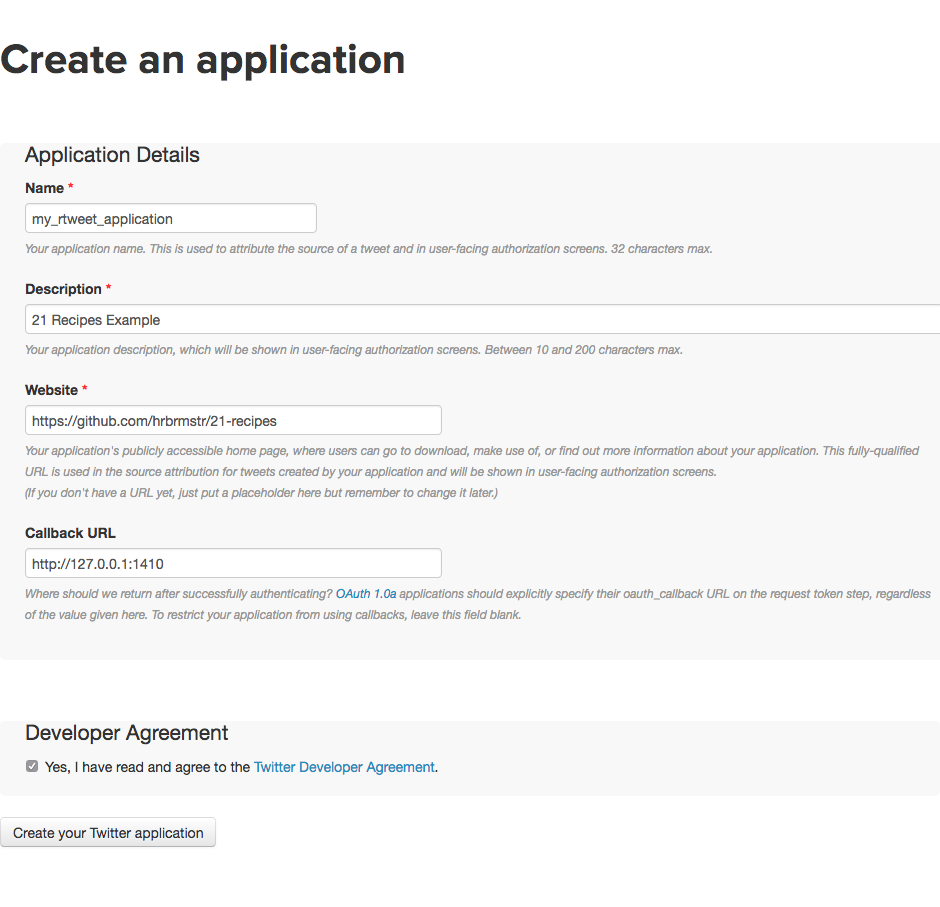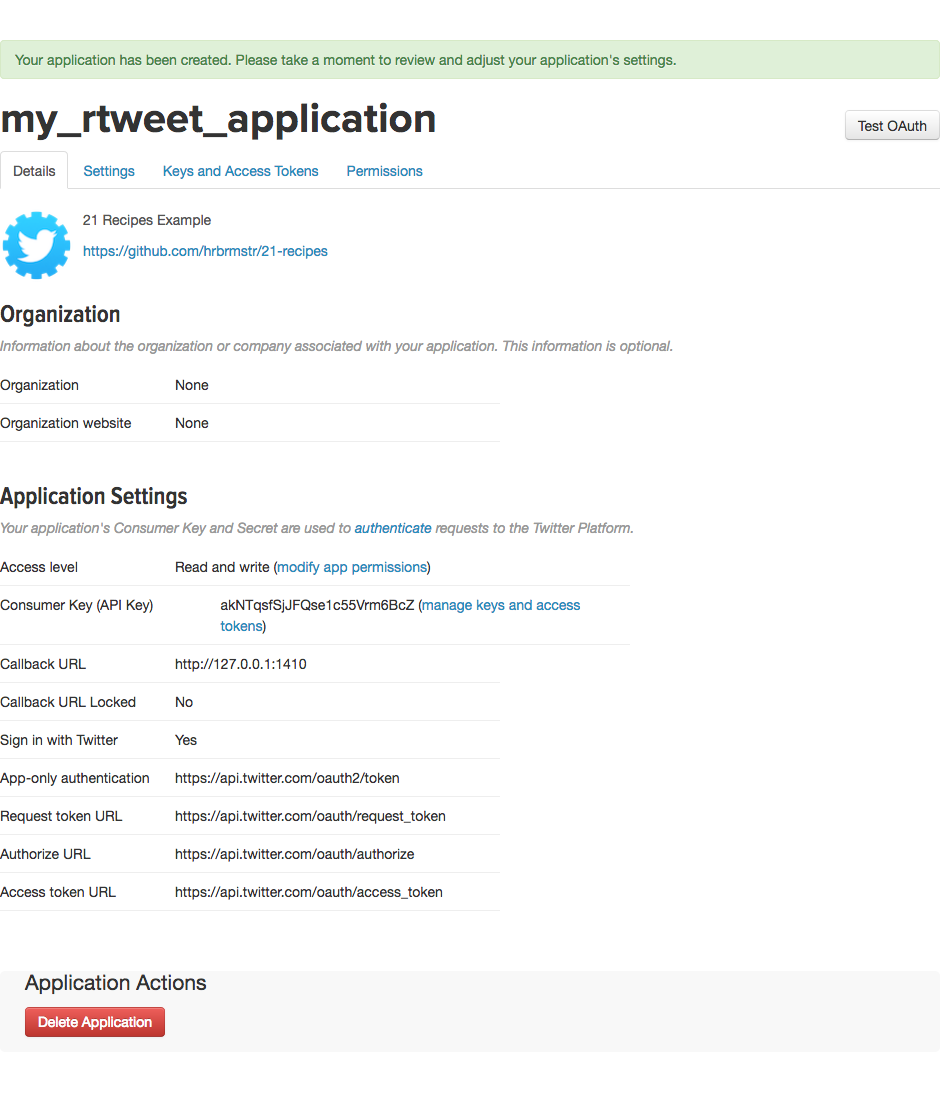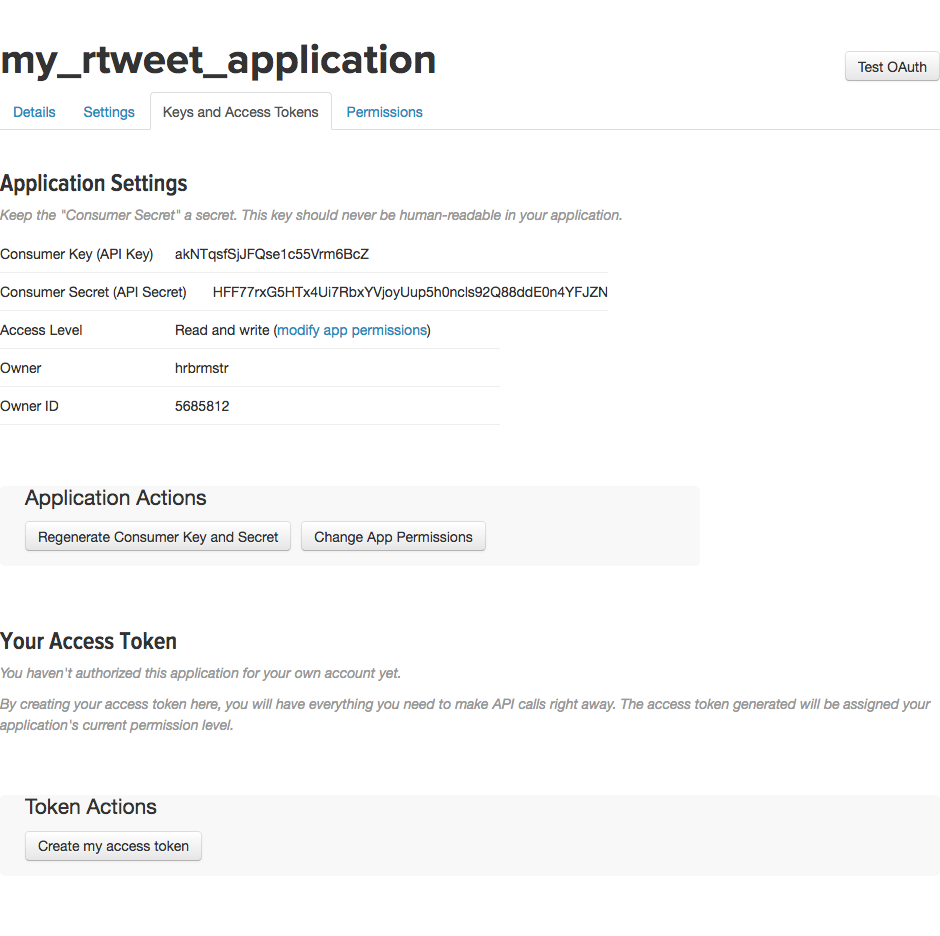Recipe 1 Using OAuth to Access Twitter APIs
1.1 Problem
You want to access your own data or another user’s data for analysis.
1.2 Solution
Take advantage of Twitter’s OAuth implementation to gain full access to Twitter’s entire API.
1.3 Discussion
Twitter uses OAuth Core 1.0 Revision A (“OAuth 1.0a” for short & to further reduce verbosity, “oauth” from now on). A few, key purposes of oauth in the context of Twitter are:
- to ensure end-users know an application is registered with Twitter, and
- know who the author(s) of the application are;
- enable limiting what operations an application can perform with your Twitter account;
- obviate the need to share your actual Twitter username and password with a third party, which also
- enables revocation of application access to your Twitter account without resetting your password.
The rtweet package takes this one step further by having you create an “application”, which is nothing more than you setting up some basic configuration information. To do so, you must visit apps.twitter.com and create a new application. You will need to provide values for the following fields:
Name: something you’ll rememberDescription: another place you can remind yourself what this is forWebsite: something that points to information you can use to associate this app when you’ve forgotten about it 5 years from nowCallback URL: This must behttp://127.0.0.1:1410(we’ll see why in a moment)- tick the agreement checkbox

Once you submit that form, you’ll see a new page:

Select the “Keys and Access Tokens” tab to see important information you’ll need:

From the previous page and this page, you’ll need the:
- Application Name (which is
my_rtweet_applicationin this example but you need to use the one you supplied) - Consumer Key (API Key) (which is
akNTqsfSjJFQse1c55Vrm6BcZin this example but you need to use your own) - Consumer Secret (API Secret) (which is
HFF77rxG5HTx4Ui7RbxYVjoyUup5h0ncls92Q88ddE0n4YFJZNin this example, but — again — you need to use your own)
Store both of those in your ~/.Renviron file. If you’re unfamiliar with how to do that, see this handy section from “Efficient R Programming”. I prefer storing these as such:
TWITTER_APP=my_rtweet_application
TWITTER_CONSUMER_KEY=akNTqsfSjJFQse1c55Vrm6BcZ
TWITTER_CONSUMER_SECRET=HFF77rxG5HTx4Ui7RbxYVjoyUup5h0ncls92Q88ddE0n4YFJZNBy storing these values in ~/.Renviron you avoid exposing them in subdirectories or within scripts and will always be able to reference them.
Now you can enable your Twitter account with this application and create a token:
create_token(
app = Sys.getenv("TWITTER_APP"),
consumer_key = Sys.getenv("TWITTER_CONSUMER_KEY"),
consumer_secret = Sys.getenv("TWITTER_CONSUMER_SECRET")
) -> twitter_tokenYou should see a browser window appear that has an authorization form in it:

You’ll also see:
Waiting for authentication in browser...
Press Esc/Ctrl + C to abortin the R console.
The rtweet package used httr to send an oauth request to Twitter and then started up a local web server (this is why that weird localhost URL from before is necessary). When you authorize the application, the browser sends a response back to the web server httr spun up with some important, secret information that will make it possible for you to never have to do this oauth dance again.
If everything was successful, you’ll see:
Authentication complete. Please close this page and return to R.in the browser window, and:
Authentication complete.in the R console.
The next step is very important.
Save the secret token you just received this way:
then create one more environment variable in ~/.Renviron:
TWITTER_PAT=~/.rtweet.rdsThat last step will help ensure you never have to deal with oauth again (until you want to).
Keep this token file safe!! It enables anyone who has it to do virtually anything with your account. If you believe it has been exposed, go back to apps.twitter.com and delete the application (you can also choose to regenerate the Consumer Key and Consumer Secret, but it’s often easier to just make a new application). You should also review your Twitter apps and ensure it’s removed from there as well. Use the Revoke access button if it is:

1.4 See Also
- The official
rtweetauthentication vignette